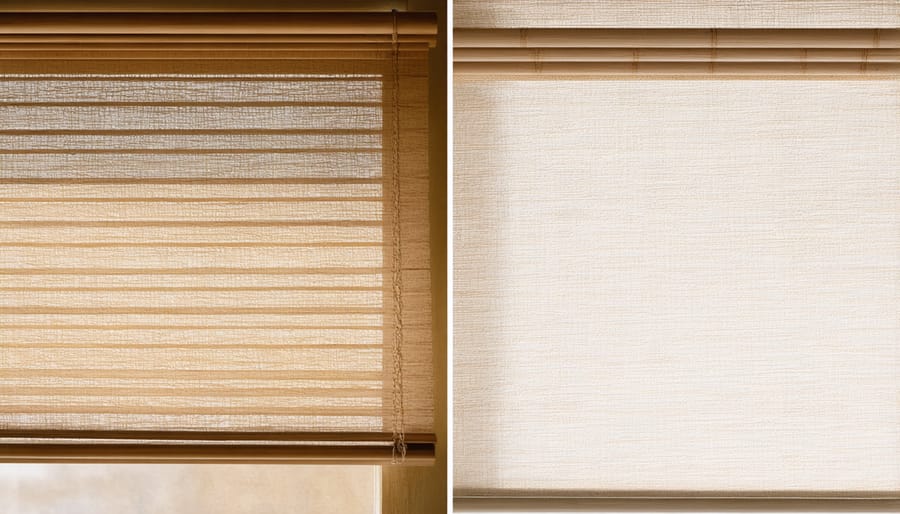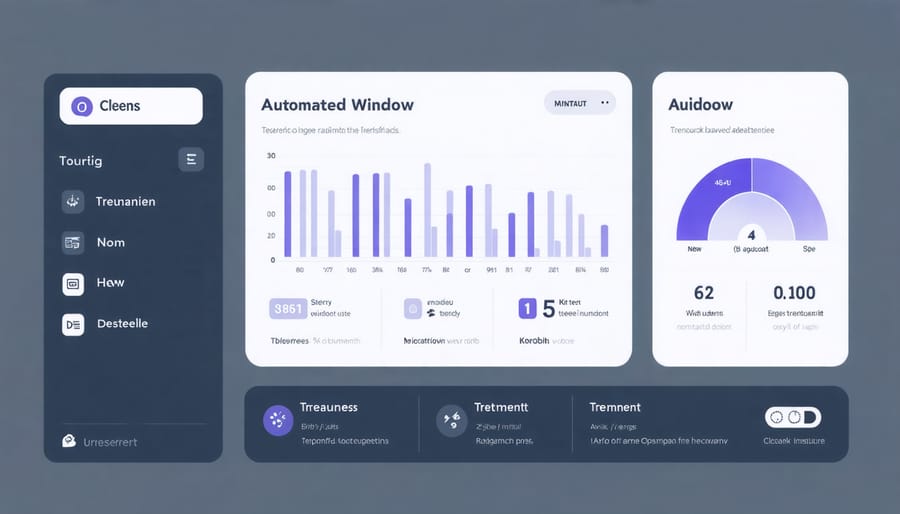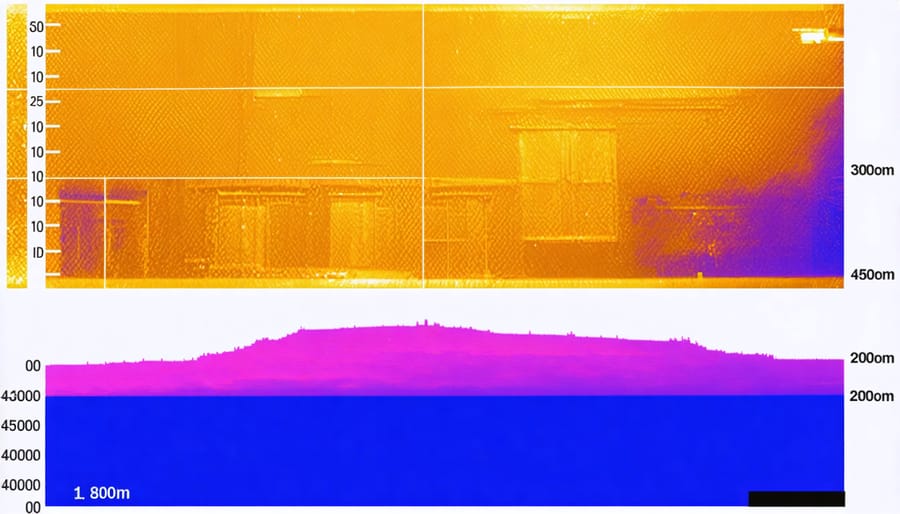Transform your home into an eco-conscious sanctuary with energy-efficient window treatments that blend style with sustainability. Modern cellular shades reduce heating costs by up to 30% while adding a sleek, contemporary aesthetic to any room. Natural bamboo and sustainably harvested wood blinds offer timeless elegance paired with remarkable durability, creating a perfect balance between environmental responsibility and design appeal. Smart motorized curtains with programmable settings optimize natural light throughout the day, minimizing electricity usage while protecting your furniture from harmful UV rays.
Beyond their environmental benefits, sustainable window treatments represent a smart investment in your home’s future. These innovative solutions not only reduce your carbon footprint but also deliver substantial energy savings month after month. Whether you’re renovating your entire home or simply updating a single room, choosing eco-friendly window treatments marks a significant step toward creating a more sustainable living space without compromising on style or comfort.
Eco-Friendly Materials Revolutionizing Window Treatments
Recycled and Renewable Fabrics
When it comes to sustainable window treatments, the fabric choice makes a huge difference in your environmental impact. Bamboo leads the pack as a rapidly renewable resource that grows without pesticides and requires minimal water. Its natural fibers create beautiful, durable window treatments that bring an organic touch to any room.
Hemp is another eco-warrior in the textile world. This incredibly sustainable crop grows quickly, enriches the soil, and requires minimal water and no pesticides. Hemp fabrics offer excellent durability and natural UV protection, making them perfect for window treatments that last.
Recycled polyester, often made from repurposed plastic bottles, gives new life to materials that might otherwise end up in landfills. These fabrics are surprisingly soft and maintain their color beautifully, while helping reduce plastic waste. Many manufacturers now offer stylish window treatments made from recycled materials without compromising on quality or appearance.
Other sustainable options include organic cotton, which uses less water and no harmful chemicals during production, and Tencel (made from wood pulp), which is produced in a closed-loop system that recycles water and solvents. These materials not only look great but also help reduce your home’s environmental footprint.
Remember that certifications like GOTS (Global Organic Textile Standard) and OEKO-TEX can help you verify the sustainability claims of your chosen fabrics. Look for these labels when shopping to ensure you’re making truly eco-friendly choices.

Natural Wood and Alternative Materials
When it comes to sustainable window treatments, natural wood and alternative materials offer both beauty and environmental benefits. Bamboo, one of the fastest-growing plants on Earth, makes an excellent choice for shades and blinds. Its rapid growth cycle and minimal need for pesticides make it an incredibly sustainable option that brings a warm, organic feel to any room.
For those seeking traditional wood options, look for products certified by the Forest Stewardship Council (FSC). These certifications ensure the wood comes from responsibly managed forests where trees are replanted and ecosystems are protected. Cedar and pine from sustainable forests are popular choices that offer natural insulation properties while adding timeless elegance to your space.
Composite materials made from recycled wood fibers and sustainable polymers present an innovative alternative. These materials often outperform traditional wood in durability and moisture resistance while maintaining a similar aesthetic. They’re particularly suitable for humid environments like bathrooms and kitchens.
Cork is another exciting option gaining popularity in window treatments. This renewable material is harvested from the bark of cork oak trees without harming them, and it naturally repels dust and allergens. Its unique texture and warm tones can add distinctive character to your windows while supporting sustainable forestry practices.
When selecting hardware and accessories, opt for recycled metals or sustainably sourced materials to complete your eco-friendly window treatment system. Many manufacturers now offer brackets and pulls made from recycled aluminum or steel, reducing the overall environmental impact of your installation.
Smart Technology Integration

Automated Climate Control
In today’s smart home era, automated climate control for window treatments represents a significant leap forward in sustainable living. These intelligent systems take the guesswork out of managing your home’s temperature and natural light, automatically adjusting your window treatments to maximize energy efficiency and comfort.
Smart motorized blinds and shades can be programmed to respond to various environmental factors. Using built-in sensors, these systems detect sunlight intensity, indoor temperature, and time of day to automatically adjust your window coverings. During summer, they’ll close during peak heat hours to reduce cooling costs, while in winter, they’ll open to harness natural solar heat.
Many systems now integrate with home automation platforms like SmartThings or Apple HomeKit, allowing you to create custom schedules and scenes. You might set your bedroom shades to gradually open at sunrise for a natural wake-up call, or have all treatments automatically adjust when you’re away at work.
The real magic happens when these systems work in concert with your home’s HVAC system. By optimizing natural light and heat gain throughout the day, automated treatments can significantly reduce your energy consumption. Some advanced systems even use weather forecasts to anticipate and prepare for temperature changes.
Installation is surprisingly straightforward, with many modern systems offering wireless options that don’t require complex wiring. While the initial investment might be higher than traditional window treatments, the long-term energy savings and increased comfort make automated climate control a smart choice for the environmentally conscious homeowner.
Energy Monitoring Features
Modern smart window treatments now come equipped with sophisticated energy monitoring features that help you track and optimize your home’s energy efficiency. These innovative systems use sensors to measure temperature differences between your windows and living space, providing real-time data through user-friendly smartphone apps.
Many of these systems include built-in thermostats and light sensors that automatically adjust your window treatments throughout the day. For example, on hot summer days, they’ll close your blinds when the sun is strongest, while opening them during winter to harness natural heat. This intelligent automation helps maintain optimal indoor temperatures without overtaxing your HVAC system.
Some advanced models even integrate with your home’s smart meter, allowing you to monitor exact energy savings from your window treatments. You’ll receive detailed reports showing how much energy you’ve saved by using these automated features, often broken down by day, week, or month.
The latest monitoring systems also offer occupancy detection, which means your window treatments adjust based on whether rooms are in use. This prevents energy waste in empty spaces while maintaining comfort in occupied areas. Many systems also provide maintenance alerts, letting you know when your window treatments need attention to maintain peak energy efficiency.
For those who love data, these monitoring features often include energy-saving goals and achievements, turning energy conservation into an engaging experience. You can even compare your savings with previous months or seasons, helping you make informed decisions about your home’s energy usage.
Energy-Efficient Design Features
Insulation Innovations
Today’s insulation technologies for window treatments have come a long way from traditional heavy curtains. Modern cellular shades, also known as honeycomb shades, feature innovative pocket designs that trap air, creating an effective barrier against heat loss in winter and heat gain in summer. These pockets work like the insulation in your walls, forming multiple layers of protection between your living space and the window.
Revolutionary materials like aerogel-infused fabrics are making waves in the window treatment industry. Originally developed for space travel, aerogel is an ultralight material that provides superior insulation while remaining translucent, allowing natural light to filter through. Some manufacturers now incorporate this technology into their window treatments, offering unprecedented insulation values.
Smart thermal materials that respond to temperature changes are another exciting development. These materials can automatically adjust their structure to provide optimal insulation based on the ambient temperature. For instance, some fabrics become more densely packed in cold weather and looser in warm conditions, naturally regulating your home’s temperature.
Multi-layer composite materials combine different insulating properties into a single treatment. These might include a reflective layer to bounce back solar heat, a thermal core for insulation, and a decorative fabric layer that complements your interior design. This thoughtful layering approach maximizes both functionality and aesthetics while maintaining a slim profile.

Solar Heat Management
Managing solar heat through your windows is a game-changer for both your comfort and energy bills. During summer, your windows can turn your home into a greenhouse, while in winter, they might let precious warmth escape. The good news is that there are several effective strategies to control this solar dance.
Start by understanding your windows’ orientation. South-facing windows receive the most direct sunlight, making them prime candidates for heat management solutions. Consider installing cellular shades, which create air pockets that act as natural insulators. These can reduce heat gain in summer by up to 60% and heat loss in winter by around 40%.
Reflective window films are another excellent option, especially for large windows that receive intense sunlight. These films bounce back solar radiation while still allowing natural light to filter through. For a more natural approach, exterior awnings or overhangs can block high-angle summer sun while welcoming warming winter rays.
Don’t overlook the power of strategic timing. Opening your window treatments during winter days captures free solar heat, while closing them at night keeps that warmth inside. Reverse this pattern in summer by closing treatments during peak heat hours and opening them when temperatures cool down.
Remember, layering different window treatments can maximize their effectiveness. Combining cellular shades with thermal curtains, for instance, creates multiple barriers against heat transfer while giving you more control over light and temperature throughout the day.
Installation and Maintenance Tips
Getting the most out of your sustainable window treatments starts with proper installation and regular maintenance. While professional installation is always an option, many cost-effective window solutions can be installed as DIY projects with the right tools and patience.
Before installation, carefully measure your windows twice to ensure a perfect fit. This prevents energy loss through gaps and extends the life of your treatments. When installing cellular shades or thermal curtains, mount them as close to the window as possible, with side channels if available, to create an effective air barrier.
For optimal performance, check these maintenance points seasonally:
– Dust cellular shades gently with a soft brush or vacuum attachment
– Clean fabric curtains according to manufacturer instructions
– Tighten any loose hardware
– Test mechanical parts for smooth operation
– Check weatherstripping and seals around window frames
– Clear any debris from tracks or channels
During winter, open your treatments during sunny days to let in natural heat, and close them at sunset to retain warmth. In summer, do the opposite – keep them closed during peak sun hours to block heat gain.
For roller shades and cellular shades, avoid yanking or pulling too hard, as this can damage the mechanism. When raising cellular shades, support the bottom rail to maintain even folding. For curtains, regularly check the rod supports and ensure they’re securely mounted to handle the fabric weight.
Clean your window treatments at least twice a year, more often in dusty areas or homes with pets. This maintains their effectiveness and extends their lifespan. For automated systems, check battery levels monthly and keep sensors clean for proper operation.
Remember that proper care of your sustainable window treatments isn’t just about maintenance – it’s about optimizing their performance to maximize energy savings and comfort in your home.
Making the switch to sustainable window treatments is more than just a trend – it’s a meaningful step toward creating an eco-friendly home while enjoying tangible benefits. By choosing sustainable options like bamboo shades, recycled fabric curtains, or cellular blinds, you’re not only reducing your environmental footprint but also making a smart investment in your home’s comfort and efficiency.
These eco-conscious choices help lower energy bills through improved insulation, protect your furniture from harmful UV rays, and create a healthier indoor environment. Many sustainable window treatments are also incredibly durable, meaning they’ll need to be replaced less frequently, further reducing waste and long-term costs.
Remember that every small choice matters when it comes to sustainability. Whether you start with one room or transform your entire home, choosing eco-friendly window treatments contributes to a more sustainable future. Consider your specific needs – climate, room function, and aesthetic preferences – when selecting your sustainable window solutions.
As you embark on your sustainable home improvement journey, keep in mind that the initial investment often pays for itself through energy savings and increased home value. By making mindful choices today, you’re creating a more comfortable living space while helping protect our planet for future generations. Start small, think long-term, and enjoy the benefits of beautiful, sustainable window treatments that align with both your values and your lifestyle.
